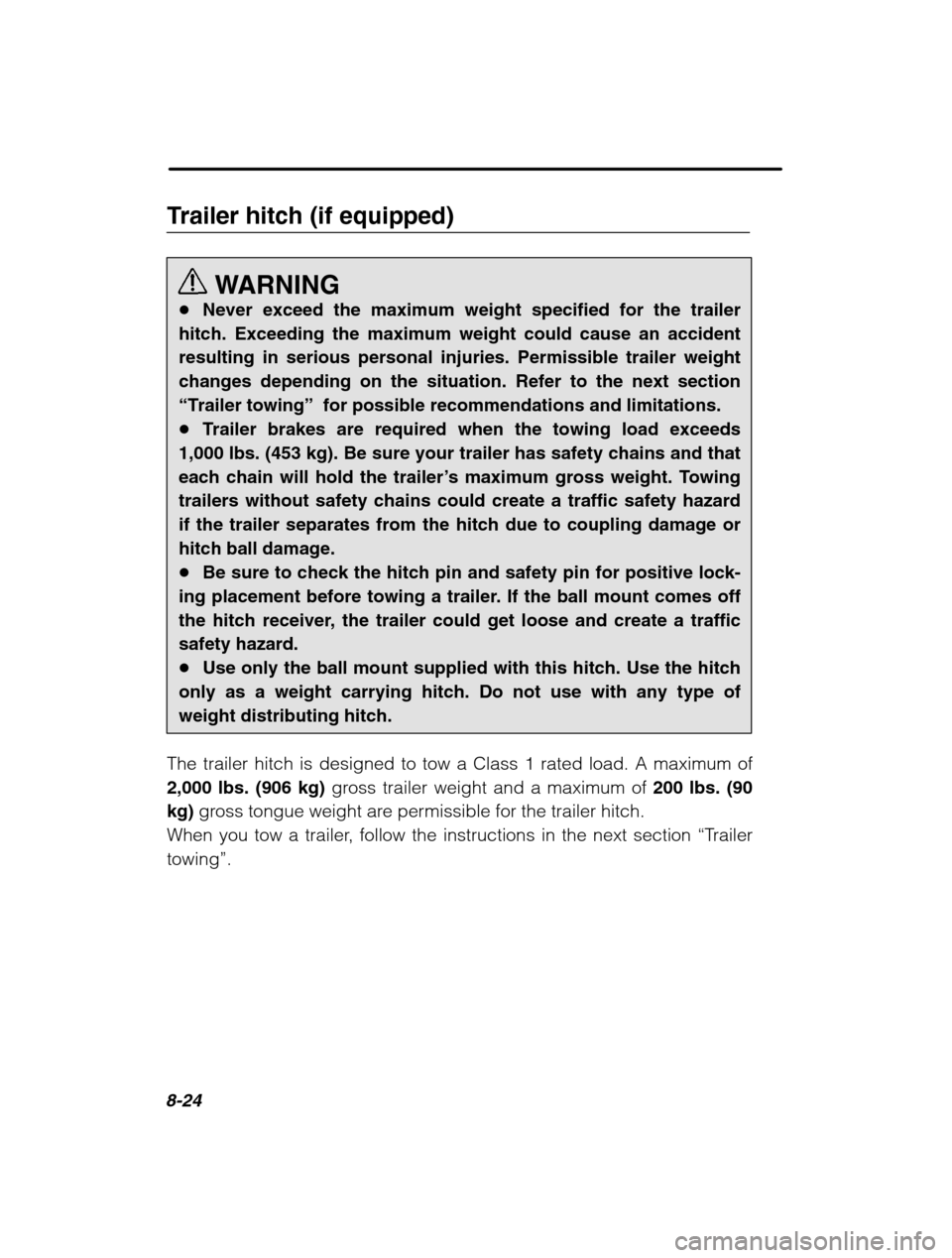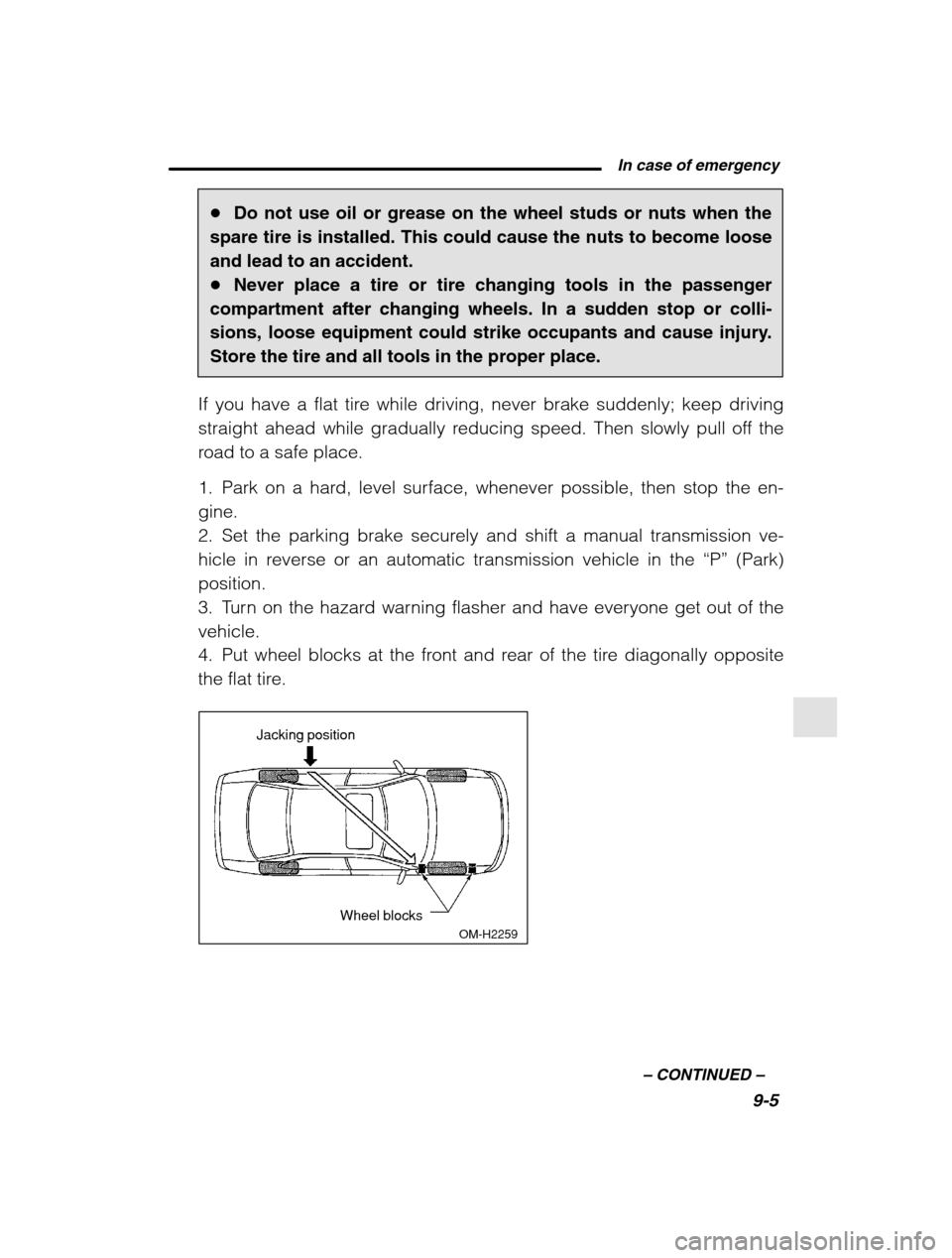Page 304 of 466

8-8
and otherwise similar to on-road driving conditions. Operating it under other than those conditions could subject the vehicle to excessive
stress which might result in damage not eligible for repair under war-
ranty. If you do take your SUBARU off road, you should review the
common sense precautions in the next section (applicable to the
OUTBACK) for general guidance. But please keep in mind that your
vehicle’s off-road capabilities are more limited than those of the OUT-
BACK.
Never attempt to drive through pools and puddles, or roads flooded
with water. Water entering the engine air intake or the exhaust pipe or
water splashing onto electrical parts may damage your vehicle andmay cause it to stall. � OUTBACK
Because of the AWD feature and higher ground clearance, your
Subaru can be driven on ordinary roads or off-road. But please keep
in mind that an AWD Subaru is a passenger car and is neither a con-
ventional off-road vehicle nor an all-terrain vehicle. If you do take your
Subaru off-road, certain common sense precautions such as the fol-lowing should be taken: � Make certain that you and all of your passengers are wearing seat
belts. � Carry some emergency equipment, such as a towing rope or
chain, a shovel, wheel blocks, first aid kit and portable phone or citi-zens band radio.� Drive carefully. Do not take unnecessary risks by driving in danger-
ous areas or over rough terrain.� Slow down and employ extra caution at all times. When driving off-
road, you will not have the benefit of marked traffic lanes, banked
curves, traffic signs and the like.� Do not drive across steep slopes. Instead, drive either straight up
or straight down the slopes. A vehicle can much more easily tip over
sideways than it can end over end. Avoid driving straight up or down
slopes that are too steep.� Avoid sharp turning maneuvers, especially at higher speeds.
� Do not grip the inside or spokes of the steering wheel. A bad
Page 307 of 466

Driving tips8-11
–
CONTINUED –
Keep the door locks from freezing by squirting them with deicer or glycerin.
Forcing a frozen door open may damage or separate the rubber
weather strips around the door. If the door is frozen, use hot water to
melt the ice, and afterwards thoroughly wipe the water away.
Use a windshield washer fluid that contains an antifreeze solution. Do
not use engine antifreeze or other substitutes because they may dam-age the paint of the vehicle. nBefore driving your vehicle
Before entering the vehicle, remove any snow or ice from your shoes
because that could make the pedals slippery and dangerous.
While warming up the vehicle before driving, check that the accelera-
tor pedal, brake pedal, and all other controls operate smoothly.
Clear away ice and snow that has accumulated under the fenders to
avoid making steering difficult. During severe winter driving, stop
when and where it is safe to do so and check under the fenders peri-
odically. n Parking in cold weather
WARNING
Snow can trap dangerous exhaust gases under your vehicle. Keep snow clear of the exhaust pipe and from around your
vehicle if you park the vehicle in snow with the engine running.
Do not use the parking brake when parking for long periods in cold
weather since it could freeze in that position. Instead, observe the fol-lowing:
1. Place the shift lever in “1” or “R” for manual transmission vehicles,
and in “P” for automatic transmission vehicles.
2. Use tire stops under the tires to prevent the vehicle from moving.
When the vehicle is parked in snow or when it snows, raise the wiper
blades off the glass to prevent damage to them.
Page 308 of 466

8-12
When the vehicle has been left parked after use on roads heavily cov-
ered with snow, or has been left parked during a snowstorm, icingmay develop on the brake system, which could cause poor braking
action. Check for snow or ice buildup on the suspension, disc brakes
and brake hoses underneath the vehicle.
If there is caked snow or ice, remove it, being careful not to damage
the disc brakes and brake hoses and ABS harness. nRefueling in cold weather
To help prevent moisture from forming in the fuel system and the risk
of its freezing, use of an antifreeze additive in the fuel tank is recom-
mended during cold weather.
Use only additives that are specifically designed for this purpose.
When an antifreeze additive is used, its effect lasts longer if the tank is
refilled whenever the fuel level reaches half empty. If your SUBARU is not going to be used for an extended period, it is
best to have the fuel tank filled to capacity. � Driving on snowy and icy roads
WARNING
Do not use the cruise control on slippery roads such as snowy or icy roads. This may cause loss of vehicle control.
To prevent skidding and slipping, avoid sudden braking, abrupt ac-
celeration, high-speed driving, and sharp turning when driving on
snowy or icy roads.Always maintain ample distance between your vehicle and the vehicleahead of you to avoid the need for sudden braking.
To supplement the foot brake, use the engine brake effectively to con-
trol the vehicle speed. (Shift into a lower gear when necessary.)
Avoid shifting down abruptly. Such behavior can cause the wheels to
lock, possibly leading to loss of vehicle control.
An anti-lock brake system (ABS) enhances your vehicle ’s braking per-
formance on snowy and icy roads. Refer to the “ABS (Anti-Lock Brake
System)” and “VDC (Vehicle Dynamics Control) system ” section in
chapter 7 for information on braking on slippery surfaces.
Page 320 of 466

8-24
Trailer hitch (if equipped)WARNING
� Never exceed the maximum weight specified for the trailer
hitch. Exceeding the maximum weight could cause an accident resulting in serious personal injuries. Permissible trailer weight
changes depending on the situation. Refer to the next section“ Trailer towing ” for possible recommendations and limitations.
� Trailer brakes are required when the towing load exceeds
1,000 lbs. (453 kg). Be sure your trailer has safety chains and that
each chain will hold the trailer ’s maximum gross weight. Towing
trailers without safety chains could create a traffic safety hazardif the trailer separates from the hitch due to coupling damage orhitch ball damage.� Be sure to check the hitch pin and safety pin for positive lock-
ing placement before towing a trailer. If the ball mount comes off
the hitch receiver, the trailer could get loose and create a trafficsafety hazard.� Use only the ball mount supplied with this hitch. Use the hitch
only as a weight carrying hitch. Do not use with any type ofweight distributing hitch.
The trailer hitch is designed to tow a Class 1 rated load. A maximum of
2,000 lbs. (906 kg) gross trailer weight and a maximum of 200 lbs. (90
kg) gross tongue weight are permissible for the trailer hitch.
When you tow a trailer, follow the instructions in the next section “Trailer
towing”.
Page 335 of 466

Driving tips8-39
–
CONTINUED –
nearest SUBARU dealer. nDriving on grades
� Before going down a steep hill, slow down and shift into lower gear
(if necessary, use 1st gear) in order to utilize the engine braking effect
and prevent overheating of your vehicle ’s brakes. Do not make sud-
den downshifts.� When driving uphill in hot weather, the air conditioner may turn off
automatically to protect the engine from overheating.� When driving uphill in hot weather, pay attention to the water tem-
perature gauge pointer (for all vehicles) and AT OIL TEMP warning
light (for AT vehicles) since the engine and transmission are relatively
prone to overheating under these conditions. If the water temperature
gauge pointer approaches the OVERHEAT zone or the AT OIL TEMP
warning light illuminates, immediately switch off the air conditioner
and stop the vehicle at the nearest safe place. Refer to the “Engine
overheat” section in chapter 9, and “Warning and indicator lights ”
section in chapter 3.� If your vehicle has a automatic transmission, avoid using the accel-
erator pedal to stay stationary on an uphill slope instead of using theparking brake or foot brake. That may cause the transmission fluid to
overheat. Also, if your vehicle is equipped with an automatic transmis-sion, avoid driving with the gear selector lever in “D” when towing a
heavy trailer to prevent fluid overheating. n Parking on a grade
Always block the wheels under both vehicle and trailer when parking.
Apply the parking brake firmly. You should not park on a hill or slope.But if parking on a hill or slope cannot be avoided, you should takethe following steps:
1. Apply the brakes and hold the pedal down.
2. Have someone place wheel blocks under both the vehicle and
trailer wheels.
3. When the wheel blocks are in place, release the regular brakes
slowly until the blocks absorb the load.
4. Apply the regular brakes and then apply the parking brake; slowly
release the regular brakes.
Page 341 of 466

In case of emergency9-5
–
CONTINUED –
�Do not use oil or grease on the wheel studs or nuts when the
spare tire is installed. This could cause the nuts to become loose and lead to an accident.� Never place a tire or tire changing tools in the passenger
compartment after changing wheels. In a sudden stop or colli-
sions, loose equipment could strike occupants and cause injury.Store the tire and all tools in the proper place.
If you have a flat tire while driving, never brake suddenly; keep driving
straight ahead while gradually reducing speed. Then slowly pull off the
road to a safe place.
1. Park on a hard, level surface, whenever possible, then stop the en- gine.
2. Set the parking brake securely and shift a manual transmission ve-
hicle in reverse or an automatic transmission vehicle in the “P” (Park)
position.
3. Turn on the hazard warning flasher and have everyone get out of thevehicle.
4. Put wheel blocks at the front and rear of the tire diagonally opposite
the flat tire.
OM-H2259
Jacking position
Wheel blocks
Page 342 of 466
9-6
5. Take out the spare tire, jack, and wheel nut wrench.
HB6008BCHB9003BB
HS0252
Temporary spare tire
HBF015CB
Jack handle
Jack
Spare tireHB8004BD
The spare tire is stored under the floor of the trunk or cargo area.
To remove the spare tire, proceed as follows:Sedan: Remove the floor cover from the trunk. Remove the storage tray.
Turn the attaching bolt counterclockwise, then take the spare tire out.Station wagon: Open the lid and hang the hook provided on the under-
Page 343 of 466
In case of emergency9-7
–
CONTINUED –
side of the lid on the rear edge of the roof to keep the lid open.
Remove the storage tray. Turn the attaching bolt counterclockwise, then
take spare tire out.
If the spare tire provided in your vehicle is a temporary spare tire, care-
fully read the section “Temporary spare tire ” in this chapter and strictly
follow the instructions.
HB7008CD
HB9001BB
The jack is stored on the left side of the trunk or cargo area.
To take out the jack:
Remove the cover, turn the jackscrew counterclockwise to loosen it, then
remove the jack.
The jack handle is stored under the spare tire cover. NOTE Make sure the jack is well lubricated before using it.